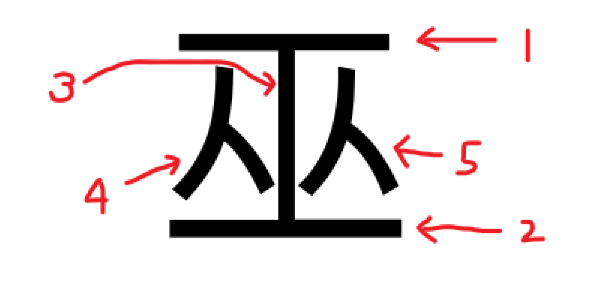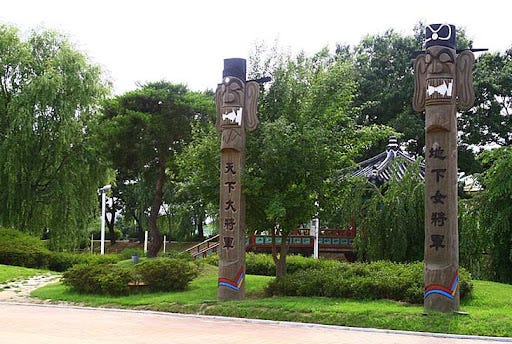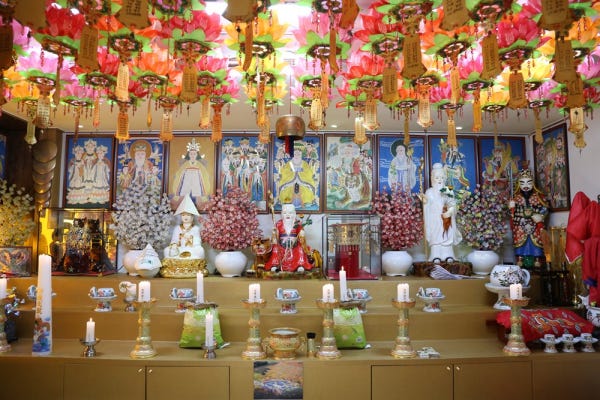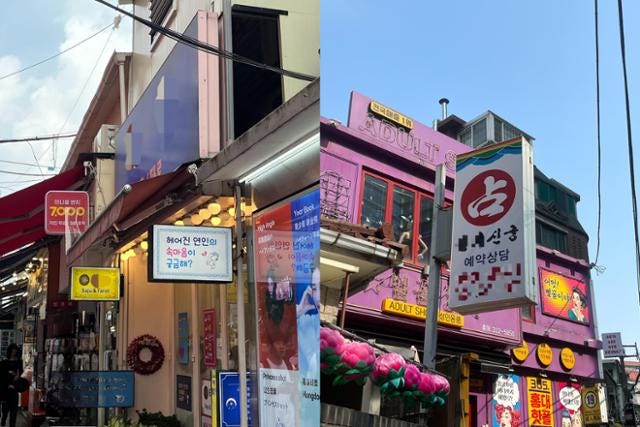I’m not a religious person but I find certain aspects of religion, including local indigenous shamanism, incredibly fascinating.
This is a Chinese character that means “shamanism.” I think it’s pronounced as wu in Chinese but it’s moo (무) in Korean. A shaman in Korean is 무당, moo-dahng.
I’ve mentioned in passing before that Chinese writing is logographic, meaning that the letter itself carries its meaning, much like the Egyptian hieroglyphs.
Not all, but some Chinese characters are constructed in Lego block style—you put different but complete letters together to make up a new letter. For instance in this case, the element 1 (straight horizontal line, or “1”) signifies “the heavens.” Element 2 “the earth” and element 3 “the connection.” Elements 4 and 5, obviously same character, means a “person.” Put everything together? You have a letter that signifies “someone (shaman) who helps a person of this living world (element 4) communicate with the person of the netherworld (element 5) by connecting the heaven and earth.” (Again, I need to do a separate post on Chinese letters in Korean language…)
For those who’ve been to Korea, you might have seen these wooden statues called 장승 (jang-seung).1 Probably not in Seoul but in the countryside or at tourist attractions. These carvings resemble totems of various cultures in their looks and purpose in that they’re meant to ward off evil spirits and protect the village and its people. These are the oldest concrete sign of Korean brand of shamanism taking hold in its land.
Although it is unclear when these wooden (sometimes stone) poles were first created,2 the story of how they came into being is known. It is one of thousands upon thousands of tales and oral traditions that have been passed down from generations ago, this particular tale from about 2,000 years ago.
The following is the story of Princess Bari.3
In an ancient Korean kingdom known as 불라 (Bool-La),4 there lived a King and his Queen. A foreseer told the King that he should wait one year before he and his wife start having children and that if he didn’t, he would end up having 7 daughters. The King didn’t heed the advice and consummated, and had 6 daughters in a row, for whom he had great love for. But when the 7th child happened to be another daughter, he got very angry and told his Queen to “dispose” of the infant. Thus the name 바리데기 (Bari-degi)5, which literally means “the one who was thrown away.”
Picked up and reared by a poor old couple, the bright young princess grows up and finds out that she’d been abandoned by her biological parents. When she’s 15, the King falls ill and no treatment can help him, until another foreseer6 appears and tells him, “The only cure is the water of life in the netherworld, guarded by the gatekeeper.7”
All 6 daughters refuse to go and the King sends for his youngest daughter that he’s abandoned. Princess Bari obliges to her duty as a daughter and sets out on her journey to the world of the dead.
When she finally reaches her destination, the gatekeeper of the dead world (or, how about “Korean Charon”) greets her and says, “You have to work 9 years for me and spend 7 more years and have 7 sons with me before you can get what you want.” So she does, and is finally able to get her hands on the potion.
As Princess Bari returns home with her “husband” and 7 sons, she sees the funeral procession of both her parents. Princess Bari brings her parents back to life with the elixir. Elated, the King offers to give half of the land to Bari but she refuses and elects to return to the underworld and look after the dead souls.
Princess Bari’s husband (formerly the gatekeeper) eventually becomes 장승 (jang-seung), shown above, and Bari herself the caretaker of the dead souls.
It is easy to confuse Korean shamanism with Buddhism and Taoism. Over the years, many features of them, along with ancient local traditions, have melded together to form a unique brand of belief systems, exorcising, fortunetelling, and other spirit-related practices. Feng-shui, you can say, is a branch of shamanism also—the principles of which are based on the Buddhist and Taoist teachings.
But unlike Buddhism or Taoism, Korean shamans have and serve their own gods. I should say demi-gods because most of these deities the shamans pray to, or supposedly communicate with, were actual historical people. The most famous being General Choi Young (최영, 14th century) and Admiral Yi Soon-shin (이순신, 16th century). Get this, there are shamans who serve Gen. Douglas MacArthur and even Joan of Arc as their gods!!
But of course, the original “deity” for Korean shamans is Princess Bari because she’s the first person ever known, mythically of course, to have crossed that River Styx and not only communicate with but take care of the dead’s souls.
I’ve recently come across a rather disturbing data set which showed that the number of Korean shamans and fortunetellers today is over 1 million, possibly close to 1.5 million. Perhaps it’s a reflection on the society too—how hard life must be for a lot of (young) people to be searching for answers from questionable sources. However, to be completely honest, despite the dubious method by which these people go about their business, I personally can’t dismiss the practice as a complete horseshit because I have seen too many things with my own two eyes.
I shouldn’t say an “eyesore” but it was a little troubling to see that there are streets in Seoul and in other big cities where these shamans/fortunetellers are concentrated in. Even when you walk down the famous Hongdae shopping district, there is a section of the neighborhood where fortunetellers and tarot card readers are lined on both sides of the road.

I’ll conclude this story with something that shows you how widespread and deeply the Korean shamanism has penetrated the fabric of Korean society.
There is this thing called “손 없는 날” which means “Days of the Month without Loss.” Each day of the month that ends in 9 or 0 (lunar calendar) is thought to be the days when foul spirits rest. So when you’re ready to move to a new residence, open a new business, get married, or any other important events of your life, there is this strong belief that you should schedule it on those days without loss. Older generation of Koreans follow this rule to a tee, regardless of their religious beliefs.
Always in pairs, one ruling over the heavens and the other the land.
Very first record of it being built is during the 7th century, but probably older.
There are different versions of the story. I’m going with the most well-known one but the ending is the same for all versions.
Thought to be one of the many city-states that existed during the pre-Three Kingdom period, c. 3rd~2nd century BCE.
The suffix 데기 (~degi) is a derogatory form of “someone who ~” and 바리 is derivation of the verb 버리다 which means to throw away.
Shows us that fortunetellers have been with us for a very, very long time.
No appropriate translation for what this being is. “Guardian” or “Gatekeeper” of the underworld.












Your writings are always engaging. I looked up & enjoyed an AI discussion about Feng-Shui. I think humans have forever tried to understand the inexplicable and/or the unknowable by means of the human perception be it vision, touch, smell, sound, taste and when they found the physical explanations inadeguate they thereby resorted to some sort of sixth sense which often became part of a religious practice. The use of mathematics and science became another way of describing the world humans experienced and through those discoveries and inventions, mankind has engineered some pretty amazing phenomena (flying, photography, microscopes, chemistry, gasoline engines, electricity come to mind). In one of your essays you shared a photo of a street in Seoul that was devoted to plastic surgery, and now the shaman street is a stark contrast. Fascinating history.